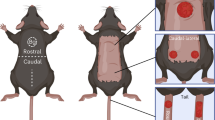Abstract
Wound healing is a spatially and temporally regulated process that progresses through sequential, yet overlapping phases and aims to restore barrier breach. To study this complex process scientists use various in vivo and in vitro models. Here we provide step-by-step instructions on how to perform and employ an ex vivo wound healing model to assess epithelization during wound healing in human skin.
An erratum to this chapter is available at http://dx.doi.org/10.1007/978-1-62703-505-7_34
An erratum to this chapter can be found at http://dx.doi.org/10.1007/978-1-62703-505-7_34
Access this chapter
Tax calculation will be finalised at checkout
Purchases are for personal use only
Similar content being viewed by others
References
Barrientos S, Stojadinovic O, Golinko MS, Brem H, Tomic-Canic M (2008) Growth factors and cytokines in wound healing. Wound Repair Regen 16:585–601
Kratz G (1998) Modeling of wound healing processes in human skin using tissue culture. Microsc Res Tech 42:345–350
Lee B, Vouthounis C, Stojadinovic O, Brem H, Im M, Tomic-Canic M (2005) From an enhanceosome to a repressosome: molecular antagonism between glucocorticoids and EGF leads to inhibition of wound healing. J Mol Biol 345:1083–1097
Stojadinovic O, Brem H, Vouthounis C, Lee B, Fallon J, Stallcup M, Merchant A, Galiano RD, Tomic-Canic M (2005) Molecular pathogenesis of chronic wounds: the role of beta-catenin and c-myc in the inhibition of epithelialization and wound healing. Am J Pathol 167:59–69
Pastar I, Stojadinovic O, Krzyzanowska A, Barrientos S, Stuelten C, Zimmerman K, Blumenberg M, Brem H, Tomic-Canic M (2010) Attenuation of TGFbeta signaling pathway in chronic venous ulcers. Mol Med 16:92–101
Pullar CE, Grahn JC, Liu W, Isseroff RR (2006) Beta2-adrenergic receptor activation delays wound healing. FASEB J 20:76–86
Roupe KM, Nybo M, Sjobring U, Alberius P, Schmidtchen A, Sorensen OE (2009) Injury is a major inducer of epidermal innate immune responses during wound healing. J Invest Dermatol 130:1167–1177
Heilborn JD, Nilsson MF, Kratz G, Weber G, Sorensen O, Borregaard N, Stahle-Backdahl M (2003) The cathelicidin anti-microbial peptide LL-37 is involved in re-epithelialization of human skin wounds and is lacking in chronic ulcer epithelium. J Invest Dermatol 120:379–389
Tomic-Canic M, Mamber SW, Stojadinovic O, Lee B, Radoja N, McMichael J (2007) Streptolysin O enhances keratinocyte migration and proliferation and promotes skin organ culture wound healing in vitro. Wound Repair Regen 15:71–79
Vukelic S, Stojadinovic O, Pastar I, Rabach M, Krzyzanowska A, Lebrun E, Davis SC, Resnik S, Brem H, Tomic-Canic M (2011) Cortisol synthesis in epidermis is induced by IL-1 and tissue injury. J Biol Chem 286:10265–10275
Vukelic S, Stojadinovic O, Pastar I, Vouthounis C, Krzyzanowska A, Das S, Samuels HH, Tomic-Canic M (2010) Farnesyl pyrophosphate inhibits epithelialization and wound healing through the glucocorticoid receptor. J Biol Chem 285:1980–1988
Sivamani RK, Pullar CE, Manabat-Hidalgo CG, Rocke DM, Carlsen RC, Greenhalgh DG, Isseroff RR (2009) Stress-mediated increases in systemic and local epinephrine impair skin wound healing: potential new indication for beta blockers. PLoS Med 6:e12
Chan KL, Zhang G, Tomic-Canic M, Stojadinovic O, Lee B, Flach CR, Mendelsohn R (2008) A coordinated approach to cutaneous wound healing: vibrational microscopy and molecular biology. J Cell Mol Med 12(5B):2145–2154
Author information
Authors and Affiliations
Editor information
Editors and Affiliations
Rights and permissions
Copyright information
© 2013 Springer Science+Business Media New York
About this protocol
Cite this protocol
Olivera, S., Tomic-Canic, M. (2013). Human Ex Vivo Wound Healing Model. In: Gourdie, R., Myers, T. (eds) Wound Regeneration and Repair. Methods in Molecular Biology, vol 1037. Humana Press, Totowa, NJ. https://doi.org/10.1007/978-1-62703-505-7_14
Download citation
DOI: https://doi.org/10.1007/978-1-62703-505-7_14
Published:
Publisher Name: Humana Press, Totowa, NJ
Print ISBN: 978-1-62703-504-0
Online ISBN: 978-1-62703-505-7
eBook Packages: Springer Protocols




